Five Fords WwTW (2016)
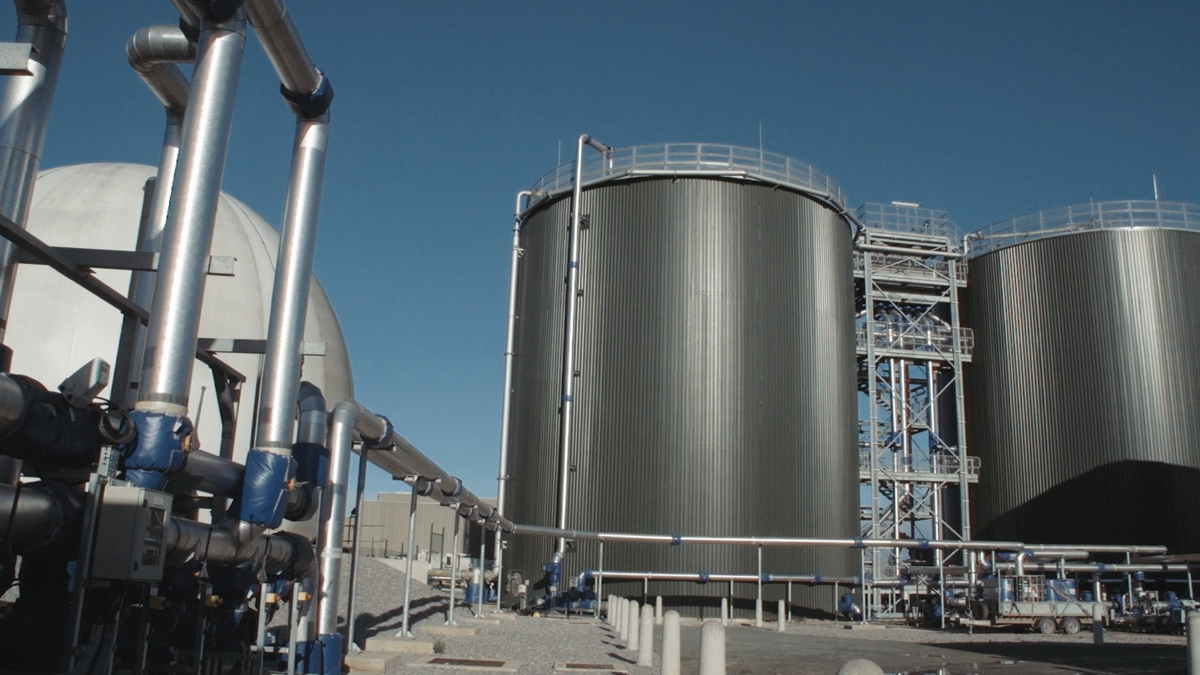
Digesters and hot water ring main - Courtesy of Dŵr Cymru Welsh Water
Five Fords WwTW is a sewage works just outside Wrexham in north-east Wales blending passive and activated sludge treatment. The works is named because there are five fords crossing the River Clywedog (Afon Clywedog) locally. The works covers a large area of land and is neighbour to fields leased to local farmers. The sewage treatment comprises 12 (No.) filter beds, referred to as ‘F-Works’ and 3 (No.) aeration lanes in ‘A-works’. The combined flow to treatment is around 300 l/s split approximately 55% flow to aeration and 45% to the filter beds. The proportion of flow to aeration can increase markedly in storm conditions when heavy rainfall doubles incoming flows.
Current facility
The total population served by the works in the Wrexham area is around 100,000. Seven tankers per day bring in sludge and domestic sewage from elsewhere in the north-east Wales and Chester area. Sludge, sewage which has undergone primary treatment, is pumped from tankers directly into the digestion plant if greater than 2.5% dry solids. Thinner domestic sewage is discharged into the works inlet.
In 2012 Welsh Water installed anaerobic digestion (AD) to increase resilience for sludge treatment. The capacity of the 2 (No.) steel clad digesters allows for 10,000 tonnes dry solids (TDS) to be processed annually using mesophilic digestion (digestion where the sludge is warmed to 40oC for a retention of 10 days to achieve the required pathogen destruction of 99%). This allows the sludge to be safely recycled to local farmland.
The majority of the heat need is met by utilising heat from 2 (No.) V12 MWM biogas engines that generate three-phase electricity to supplement the site’s energy needs. The engine water jacket collects heat and this is transferred via a heat exchanger to the site heat ring main. The hot exhaust gases are also utilised in a heat exchanger to transfer heat into the ring main. The flue stack emissions are monitored for VOCs, carbon monoxide, sulphur oxides and nitrous oxides.
An additional natural gas boiler is available to operate, using gas from the national gas grid to provide resilience for the site heating.
This resilience paved the way for the future upgrade as the installation of an intermediate gas main meant a large natural gas supply was available at site, which is now utilised for the export of renewable biomethane from the biomethane to grid plant.
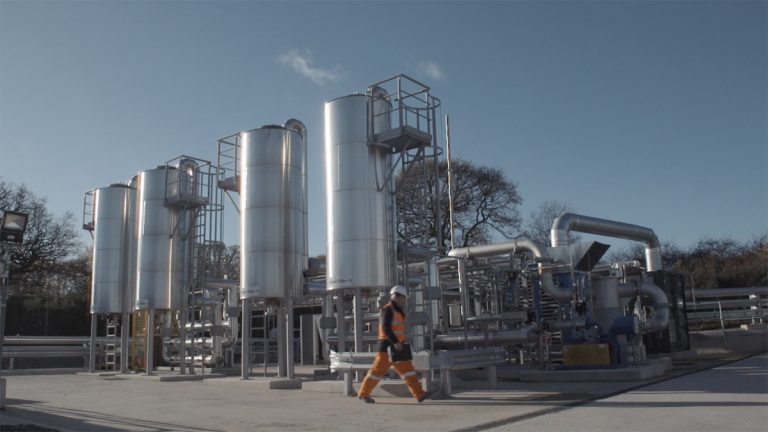
Activated carbon filters, and in the background, the screw compressor and membrane kiosk – Courtesy of Dŵr Cymru Welsh Water
Maximising benefits from renewable energy
Welsh Water always intended to commission advanced digestion at Five Fords; however, in 2014 a review of the 2015 to 2020 programme identified new innovations for maximising benefits from renewable energy at Five Fords.
The result is what Welsh Water hopes will be branded as ‘the Five Fords Energy Park’: an ambitious programme to combine six major technologies on one site: (i) The existing anaerobic digestion (ii) Combined heat and power generation improved with biomethane injection (iii) solar photo-voltaic (iv) wind (v) hydro (vi) thermal hydrolysis (or advanced anaerobic digestion).
In 2015 significant steps were taken towards achieving the resilience and energy self-sufficiency of Five Fords WwTW set out by this vision. A 2.5MW (gross) solar photo-voltaic (PV) system was installed by Dulas Ltd and an innovative biomethane to grid injection facility, designed by Grontmij with delivery managed by Kier (principal contractor) using an Air Liquide membrane plant and Elster grid entry unit, was also completed in 2015.
This enhancement will contribute to Welsh Water achieving its targets of customer bill increases being kept at least 1% below RPI inflation until 2020. In the Periodic Review 14 (PR14) OfWAT assessment of the 2015 to 2020 business plan Welsh Water also committed to a renewable energy generation measure as a benchmark for carbon savings. This figure was set at 100GWh by 2020 and the biomethane to grid plant will be one of the critical projects to achieve this.
Biomethane production
There are different technologies available for the production of biomethane. Two technologies reviewed by Welsh Water were water wash and membrane technologies.
The membrane plant, which uses very fine membranes, similar to the hairs of a broom in appearance, is able to separate carbon dioxide from methane based on the size of the gaseous molecules. This very fine membrane and operating pressure of up to 16 bar(g) separates the biogas produced from the digestion process into methane and carbon dioxide. The carbon dioxide is vented to the atmosphere and the methane becomes the biomethane which, following addition of propane and odorant, is suitable for injection into the gas grid and for use in homes and businesses.
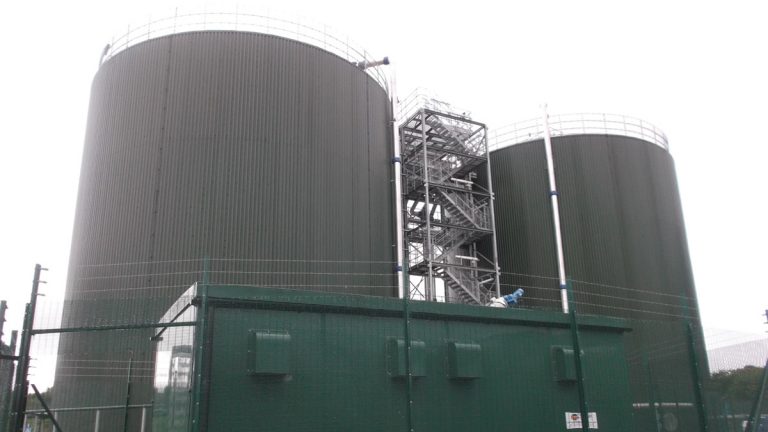
Five Fords digesters – Courtesy of Dŵr Cymru Welsh Water
The membrane technology was selected because this complex, high pressure system preserves a greater quantity of the methane from within the original biogas compared to the water wash alternative.
The Five Fords plant was the first operational biomethane to grid plant in Wales and the first membrane plant in the UK Water Industry. An overview of the process follows:
- Sludge is digested at 40oC for 10 days which yields biogas.
- Biogas is collected within a ‘gas bag’, a large 1,250m3 balloon, which has two layers and forced ventilation between the layers to prevent presence of explosive atmospheres.
- The biogas enters a siloxane scrubber which removes silicates within the gas prior to gas combustion within the engines. A gas booster and tee-off connection after the siloxane scrubber allow biogas to be shared between engines and the biomethane to grid plant as needed.
- Biogas used in the engines is burnt to produce electricity, which is predominantly used on site for wastewater treatment, and heat which provides low temperature hot water to the heat ring main which then heats the sludge in the digesters.
- Biogas which is destined for upgrade to be exported to the grid is first piped to 2 (No.) activated carbon filters which remove hydrogen sulphide (H2S). Two further activated carbon filters remove any volatile organic compounds remaining in the biogas.
- The biogas is then compressed by a screw compressor up to 16 bar(g) and forced into the membrane plant. The membrane plant separates the methane from the carbon dioxide. The carbon dioxide is vented and the methane is then sent to the grid entry facility for the final stage of the biomethane upgrade process.
- The energy content, and other critical parameters, of the gas are monitored at the biomethane grid entry facility and propane drawn from 3 (No.) liquified petroleum gas (LPG) tanks on site is used to enrich the biomethane. Until the gas achieves the criteria determined by Wales and West Utilities (WWU), the local gas network operator, the biomethane is ‘rejected’ and is circulated back to the gas bag. Once biomethane achieves the standard needed by WWU the valve between the site and the local gas network opens and biomethane is exported to the local gas network.
Progress to date and completion
Welsh Water envisages that full completion of the works at Five Fords will contribute towards its measures of success by responding to climate change through increasing the amount of renewable electricity generated, and improving the efficient operation of its business.
These will be achieved through further advanced digestion pre-treatment of the sludge which will offer several benefits. By using steam in a thermal hydrolysis plant (THP) the sludge will be more rapidly de-natured during the digestion process causing more of the solids within the sludge to be broken down and converted into biogas, and subsequently biomethane by the biomethane to grid plant. This enhances energy self-sufficiency, reduces carbon emissions from haulage and reduces the indirect carbon emissions due to any methane subsequently emitted from the sludge.
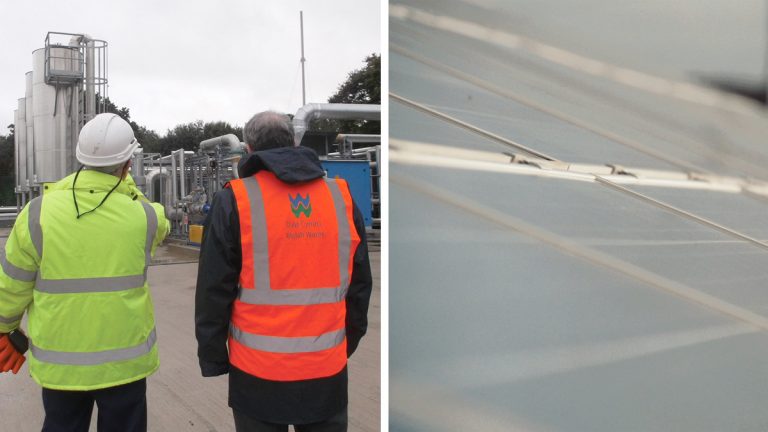
(left) Five Fords site operators with the activated carbon filters in the background and (right) Phase 1 Solar PV – Courtesy of Dŵr Cymru Welsh Water
Methane is twenty-one times more ‘warming’ to the atmosphere than carbon dioxide. Sludge recycled to land accounts for about 10% of Welsh Water’s annual carbon emissions, and is therefore a great opportunity for advanced digestion which reduces the volume of sludge recycled to land. A real environmental win-win!
The THP will also achieve a greater pathogen kill which means that the 99% pathogen kill currently achieved would be improved to 99.9999%, equivalent to the pasteurisation process. This will ensure Welsh Water meets stricter regulatory standards should they be implemented in future.
The resulting benefit of greatly increased de-naturing of sludge is that the substrate, the part of the sludge used as food by bacteria within digesters, becomes much more accessible for use as food. This means that the biogas yield per tonne of sludge solids may be increased by between 25% and 40%, dependent on the quality of sludge. This, coupled with increased sludge throughput, would triple the volume of biomethane produced at site.
The Five Fords ‘Energy Park’
To date Welsh Water has completed four parts of its innovative ‘Energy Park’. The ‘Energy Park’ will comprise advanced anaerobic digestion (currently operating as conventional anaerobic digestion), CHP, gas to grid, solar PV, hydro and wind. The majority of the renewable electricity generated would be used on site and the renewable gas would be exported to the local gas network.
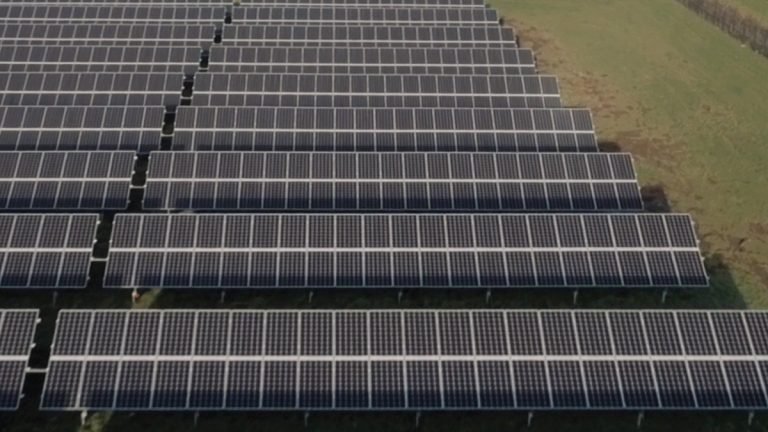
Five Fords Solar Ph 2 – Courtesy of Dŵr Cymru Welsh Water
The advanced digestion would allow Welsh Water to process an increased sludge volume through the existing digesters, which allows existing assets to absorb future population growth whilst at the same time increasing energy self-sufficiency and enhancing the quality of end product recycled to local land. The list of accolades for these technologies include:
- First operational gas to grid plant in Wales.
- First membrane gas to grid plant in the UK Water Industry.
- First UK Water industry site to dovetail so many technologies together at one site.
- First Welsh WwTW to use its outfall for hydro-electric generation.
Looking ahead
The advanced digestion proposal will be delivered by MMB and the target for completion is 2018. The hydro-turbine could be delivered by September 2017 and the proposed wind turbine soon after. Both of these will be tendered in the near future once stakeholder engagement, and subsequently, planning consents are obtained.
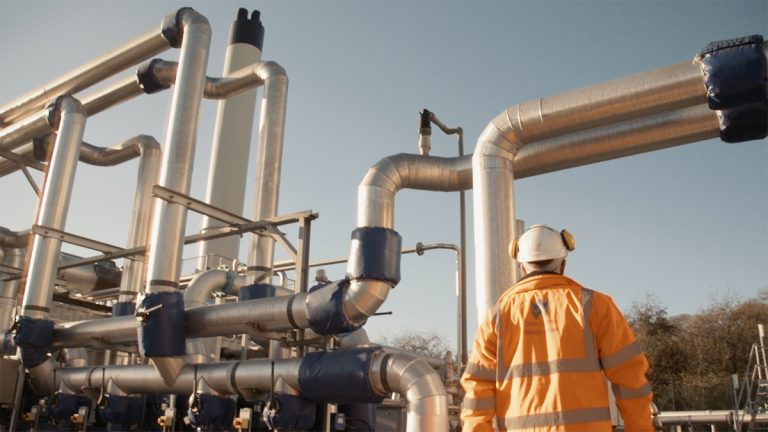
Process operator John O’Neill out on his rounds – Courtesy of Dŵr Cymru Welsh Water
These latest proposals are to undergo public engagement and consultation as immediate next steps within the wider project. Should all of these be successful, in 2020 a wastewater treatment works on the outskirts of Wrexham would be able to:
- Export 40GWh of biomethane to the local grid, enough to heat 3,000 average homes for a year.
- Generate enough electricity from the CHP engines, solar, wind and hydro to power 1,100 homes.
All of this from nothing more than the renewable sources of energy present at the site. Sounds like a win-win for Welsh Water and its customers!






